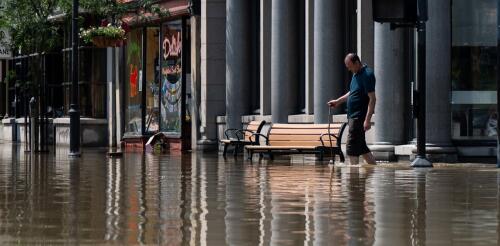Global warming
Sea level rise has already put coastal cities on notice thanks to increasing storm surges and even sunny day flooding at high tide. These challenges will continue to grow because global projections point to a mean sea level rise of at least one foot above year-2000 levels by the end of this century. However, many cities are facing another factor making them even more vulnerable to rising waters: land subsidence. The three of us – Pei-Chin Wu, Meng (Matt) Wei and Steven D'Hondt – are scientists at the University of Rhode Island Graduate School of Oceanography working with the U.S. Geological Survey to research challenges facing waterfront cities. Our findings indicate that land is sinking faster than sea levels are rising in many coastal cities throughout the world. By using radar images of the Earth’s surface collected from orbiting satellites, we measured subsidence rates in 99 coastal cities worldwide. These rates are highly variable within cities and from...
National weather analysts released their 2023 billion-dollar disasters list on Jan. 9, just as 2024 was getting off to a ferocious start. A blizzard was sweeping across across the Plains and Midwest, and the South and East faced flood risks from extreme downpours. The U.S. set an unwelcome record for weather and climate disasters in 2023, with 28 disasters that exceeded more than US$1 billion in damage each. While it wasn’t the most expensive year overall – the costliest years included multiple hurricane strikes – it had the highest number of billion-dollar storms, floods, droughts and fires of any year since counting began in 1980, with six more than any other year, accounting for inflation. 2023’s billion-dollar disasters. Click the image to expand. NOAA The year’s most expensive disaster started with an unprecedented heat wave that sat over Texas for weeks over...
The year 2023 was marked by extraordinary heat, wildfires and weather disasters. In the U.S., an unprecedented heat wave gripped much of Texas and the Southwest with highs well over 100 degrees Fahrenheit (37.8 Celsius) for the entire month of July. Historic rainfall in April flooded Fort Lauderdale, Florida, with 25 inches of rain in 24 hours. A wave of severe storms in July sent water pouring into cities across Vermont and New York. Another powerful system in December swept up the Atlantic coast with hurricane-like storm surge and heavy rainfall. The West Coast started and ended the year with flooding and mudslides from atmospheric rivers, and California was hit in August by a tropical storm – an extremely rare event there. Wildfires ravaged Hawaii, Louisiana and several other states. And Canada’s worst fire season on record sent thick smoke across large parts of North America. A person walks through a scene of destructio...
Reading down the lengthy final agreement of the COP28 United Nations climate conference held in December 2023, you’ll go a long way before finding a strong, active verb. The lengthy recitation of climate impacts “notes with concern” and occasionally with “significant concern” glaring gaps in countries’ current policies. But while countries volunteered pledges to act, they were less keen to have those pledges framed as binding agreements in the final text. Reactions to COP28’s conclusion have been understandably mixed. Going into the talks, the world was more on track to avert catastrophic warming than it would have been without the 2015 Paris Agreement, but a long way from where it needs to be. Even if all the pledges made at COP28 are implemented, the world will still exceed the Paris goal of keeping global warming under 1.5 degrees Celsius (2.7 Fahrenheit) compared to preindustrial temperatures....
Shortly after the opening ceremony of the 2023 United Nations climate negotiations in Dubai, delegates of nations around the world rose in a standing ovation to celebrate a long-awaited agreement to launch a loss and damage fund to help vulnerable countries recover from climate-related disasters. But the applause might not yet be warranted. The deal itself leaves much undecided and has been met with criticism by climate justice advocates and front-line communities. I teach global environmental politics and climate justice and have been attending and observing these negotiations for over a decade to follow the demands for just climate solutions, including loss and damage compensation for countries that have done the least to cause climate change. COP28 President Sultan Ahmed al-Jaber, center, walks with world leaders and representatives of countries to the climate summit’s opening ceremony. The loss and damage fund was one of the fi...



